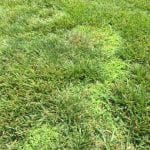(By Jared Hoyle, KSU Turfgrass Research and Extension)
 Today I was walking around the Rocky Ford Turfgrass Research Center in Manhattan, KS looking for an area to put out a postemergent crabgrass study and notice that the crabgrass on the research farm is all different stages. It is important to know what stage the crabgrass is in to help with control. That could determine your success in controlling it with postemergent herbicides
Today I was walking around the Rocky Ford Turfgrass Research Center in Manhattan, KS looking for an area to put out a postemergent crabgrass study and notice that the crabgrass on the research farm is all different stages. It is important to know what stage the crabgrass is in to help with control. That could determine your success in controlling it with postemergent herbicides
There are postemergent herbicide options out there for crabgrass control. But depending on how big or how many tillers the crabgrass has will help you determine what product to use. First, determine the size or stage of crabgrass you have present.
Here is a picture to show the tillering stages of crabgrass.
The smaller the crabgrass the easier it is to kill it. The tillered crabgrass may take more than one application and higher rates so make sure you check the label for correct application rates and intervals.
- dithopyr – Can provide control to crabgrass up to one tiller stage. This product also has preemergence activity.
- quinclorac – Can be applied on most cool- and warm-season turfgrass species. This product controls crabgrass when it is one tiller or smaller or when it has four or more tillers.
- mesotrione – Can be effective for crabgrass control but in most cases will take two applications at two week intervals. The label also states that applications must be made before the four tiller crabgrass stage.
- topramazone – Similar to mesotrione, this product will require two applications at three week intervals. Use at higher rates on crabgrass that have greater than one tiller.
- fenoxaprop – Are very effective in controlling crabgrass. Label states that this product can be applied to annual grasses up to the five tiller stage. Remember not to tank mix with products that contain 2,4-D, antagonism can occur.
As one last reminder, do not apply post emergent herbicides outside the recommended temperature on the label. This will increase the risk of turfgrass injury.
Always remember to READ THE LABEL for the correct rate, turfgrass tolerance, and specific instructions before application!!!
***Mention of trade names or commercial products in this article is solely for identification purposes and does not imply recommendation or endorsement, nor is criticism implied of similar products not mentioned by Kansas State University.***
Don’t forget to follow me on twitter @KSUTurf.
Also, visit our facebook page www.facebook.com/KSUTurf

